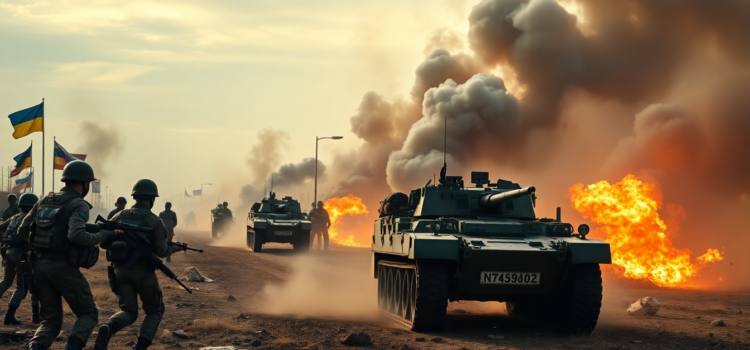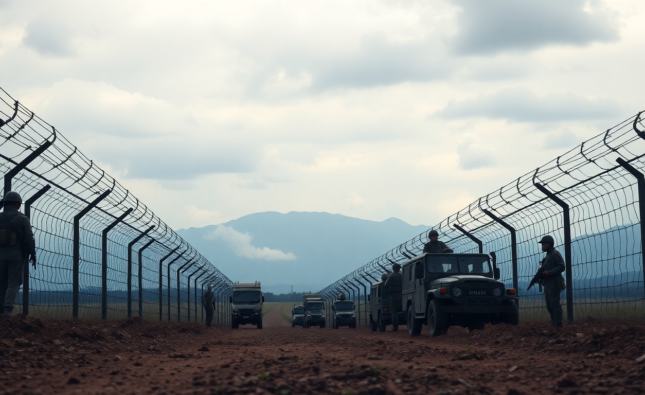
Russia Steps Up Offensive Across Front Line in Ukraine: Defiance of Trump’s Ceasefire Proposition
The geopolitical landscape in Eastern Europe is witnessing a swift escalation as Russia ramps up its military operations in Ukraine. This intensification occurs notably in the face of former U.S. President Donald Trump’s attempts to broker a ceasefire. With Moscow ignoring peace efforts, what does this mean for the ongoing conflict, and where does it leave global geopolitics?
Current Status of the War
Currently, Russia occupies approximately 18.6% of Ukrainian territory, translating to 43,381 square miles. Recently, Russian forces have incrementally increased their territorial control by 101 square miles over a 30-day timeline. Strategically significant advancements have been recorded in large parts of Ukraine, including the crucial Kursk and Sumy Oblasts. This poses immediate threats of encirclement for Ukrainian troops and threatens vital supply routes near Sudzha.
Territorial Advances and Casualties
Throughout 2024, Russian forces annexed over 4,000 square kilometers across Ukraine, reminiscent of the size of Rhode Island. This came at a sizeable human cost with over 420,000 casualties reported on the Russian side. Ukraine has suffered heavily too, having recorded 400,000 military casualties. As the humanitarian crisis deepens, over 10.2 million Ukrainians, comprising 23% of its pre invasion population, have been displaced, amplifying the socio-economic strain on its stretched resources.
Economic Impact Amidst Ongoing Offensive
The relentless marches of Russian troops have had profound economic implications. Ukraine’s economy has contracted by a staggering 22.6% since 2022, whereas Russia’s economy has observed a modest 5.6% growth. The fiscal impact is underscored as Ukraine’s budget deficit soared to 20.4% of GDP in 2024. Conversely, Russia maintained a reported deficit of only 1.7% over the same period. These numbers illustrate the depth of economic strife experienced by Ukraine amidst relentless Russian advances.
Escalation of Military Equipment Losses and Nuclear Threats
The Russia-Ukraine war escalation 2025 marks a significant loss in military hardware on both sides, with Russia having lost over 20,500 vehicles and Ukraine nearly 8,000. This has been compounded by the growing nuclear threat as Russia alters its nuclear doctrine. With tactical nuclear weapons positioned in Belarus and repeated military drills in 2023 and 2024, the specter of nuclear escalation looms larger.
Humanitarian Actions and Changing International Dynamics
The United States has consistently been a stalwart supporter of Ukraine, mobilizing $500 million in aid per month in 2024. This aid is projected to rise to $920 million in 2025. However, shifts in U.S. political dynamics under a potential Trump administration might imperil this support, potentially affecting Ukraine’s capabilities to counter Russian military power effectively.
Impact of Sanctions and Global Reactions
The imposition of sanctions has affected Russia’s capacity to sustain prolonged warfare. While the cost of war has strained Russian resources, they successfully maneuvered to soften economic impacts, partially attributed to strategic partnerships with countries beyond the Western sphere.
Ukrainian Defensive Strategies
Faced with Russian advances in Donetsk Oblast and extensive Russian missile and drone strikes, Ukraine has concentrated on fortifying its eastern borders. Strategies for counteroffensive actions in areas like Kharkiv and Sumy have been essential in counterbalancing Russian force generation. Nonetheless, the strength of Ukrainian resilience continues to play a pivotal role in this conflict’s prognosis.
Conclusion: The Future of the Russia Ukraine Conflict
As 2025 progresses, the Russia-Ukraine war takes on an increasingly complex matrix embroiled in geopolitical tension and military skirmishes. While Trump’s ceasefire propositions find little favor in Moscow, both direct and indirect impacts will necessitate nuanced responses from Western allies, particularly if major aid pipelines alter. This ongoing saga’s resolution will largely depend on Ukraine’s allies’ response to escalating war and potential shifts in political landscapes.
Call-to-Action
Stay informed on the latest developments surrounding the Ukraine-Russia conflict by joining our newsletter. Engage with us by sharing your thoughts on potential resolutions or spreading the word through social media.
FAQ Section
- What has been the impact of the Ukraine-Russia war on civilian displacement? Over 10.2 million Ukrainians have been displaced, creating an unparalleled humanitarian crisis.
- How have Ukraine’s allies responded to the escalation in war efforts? The U.S. primarily ramping up financial aid to Ukraine, although future shifts may occur under changing administrations.
- What are the economic repercussions of the conflict on Ukraine? With a decrease in the economy by over 22.6% since 2022, the ongoing war has severely hampered Ukraine’s fiscal stability.
- Is there a potential shift in military strategies expected in 2025? Yes, Russia’s expanded operations and Ukraine’s defensive strategies are indicative of evolving battlefield dynamics.
- How have sanctions affected Russia’s ability to continue the conflict? Sanctions have strained Russia’s resources but have not deterred their advances due to strategic economic partnerships elsewhere.










Comments